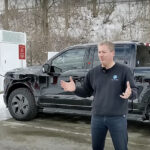It all started with Jim.
On the continuum of “importance,” “talking the talk” has its time and place. But walking the walk is irreplaceable and firmly at the far end of the importance scale. In this regard, Jim Farley, Ford’s CEO, stands out. If it hadn’t been for Jim Farley, it can arguably be said that the industry transition from CCS to NACS (SAE J3400) would have never happened.
What is the SAE J3400? Is it important? If so, why? What does an industry transition to SAE J3400 really mean? And is it truly an industry transition? Is it really a better standard than CCS? Is CCS Doomed? And why on Earth would Tesla open up its network?!
What is the SAE J3400?
Let’s start with what the SAE J3400 is not– the NACS. The NACS is what Tesla called their proprietary standard before Ford and other OEMs began to embrace it. It’s not wrong to refer to J3400 as NACS, but the distinction is that Tesla owned the NACS standard. Tesla does not own the J3400 standard.
Secondly, it is also important to note that the connector is not a network. The fact that Tesla’s Supercharger network is superior to its North American peers says more about the might of Tesla’s IT department than it does about the chunk of plastic housing bits of copper that consumers see as the NACS plug.
With those bits of pedantry out of the way…
The Society of Automotive Engineers (SAE) is the regulatory body that defines J1772 (what consumers call Level 2) and other standards that regulate EV charging. The SAE is now the governing body responsible for ensuring all OEMs adhere to the J3400 standard.
According to the SAE, the J3400 is a Work In Progress, meaning it has not yet been finalized. What the SAE has published are the J3400 recommended practices. When it is finally released as a full-fledged standard, there will be some nuances that engineers will care deeply about and that the typical consumer will never notice. And even when the standard is final, it will obviously evolve as the technology matures. This natural evolution is the raison d’exister of standards– so that things continue to work as technology matures.
But that doesn’t mean that there hasn’t been tremendous progress in developing the J3400 standard. That progress, as of this writing, has been sufficient enough that Ford and Rivian are now, with the correct adaptor, able to seamlessly charge on Tesla’s network, with most other manufacturers following in the next 12-ish months.
Why Is Adopting the J3400 Standard Important?
In my mind’s eye, I can see Frodo Baggins, high on a mountaintop, holding a NACS connector above his head and shouting, “The one plug to rule them all!”
Dramatization aside, consumer confidence must be the number one reason to adopt an industry standard. By providing a consistent and reliable EV charging experience, consumers will gain the confidence required to believe that access to charging stations is convenient and efficient, regardless of where they are traveling or what brand of car they are driving.
It is also astonishing how quickly Ford, Tesla, and the SAE made this happen. Ford made its initial announcement on May 25, 2023, and it was only nine months later that their CCS to J3400 adapter started to ship. And their engineers had no head start or even a warning, since they were completely surprised by the announcement.
What Does an Industry Transition to the SAE J3400 Really Mean?
There is no way a Board of Directors, which has a fiduciary duty to shareholders, would agree to incorporate the IP of a direct competitor into the cars their company manufactures. It would be beyond irresponsible and they would all get sued to oblivion once that competitor decided to modify that IP and then withhold that modification.
In a nutshell, the transition from NACS to SAE J3400 means that Tesla gave up its IP to the SAE to control for the benefit of all auto manufacturers, and by extension, all of society.
Is the Transition to J3400 Truly Industry-Wide?
Sort of. The J3400 takeover is complete in North America, with even late hold-outs such as Honda and Toyota announcing the switch. Some manufacturers will not make the switch until 2025, mainly due to their use of 900V architecture. In other parts of the world, J3400 never had a chance.
In Japan, J1772 for AC Level 2 charging and CHAdeMO for DCFC remain the standard. In Europe, CCS2, which supports 3-phase AC charging and is mandated by the EU, is standard. In China, GB/T is standard.
What About CCS? And EA’s Dieselgate Advantage?
CCS will be around for a long time, but the day will come when you can’t find a native CCS plug (but cars with a CCS port can use the J3400 stations with an adapter). To be clear, that day is likely more than ten years away.
When the dust settled over Dieselgate and the court-mandated structure was put into place, it was hailed as a savior of the EV industry. And maybe it was. However, the courts could not have foreseen how the Tesla Supercharger network would come to dominate the EV charging experience. Even if one’s view of Dieselgate is that it was a tremendous waste of money, I assure you it was not. Without Dieselgate, would Tesla have poured so much of its resources into the Supercharger network? And even if EA fails tomorrow (which it will not), those assets on the ground will have value for some acquiring company.
Competition is good. Electrify America and the legion of other networks that are, in 2024, primarily CCS (such as EVgo, Mercedes, ChargePoint, and Shell) will adapt and thrive, or wither and have their assets assimilated.
The EV driving public should rejoice.
Is the J3400 Really a Better Standard Than CCS?
It depends on who you ask. I know a few EV engineers who, off record, will state that CCS has better safety protocols built in. It is said that Betamax was technically superior to VHS. Consumers didn’t care then and don’t care now. If it works and is proven safe, consumers will gravitate to the one that is easiest to use.
Anyone who has used Tesla’s Superchargers knows they just work. You plug in and walk away. And stations are plentiful and rarely broken. As I said above, this says more about the might of Tesla’s IT department than it does about the NACS plug itself, but that doesn’t matter. It just works, and that’s what the EV-driving public needs.
That aside, CCS does support some advanced features that J3400 currently does not. The first is support to 1000V, which puts EVs whose drivetrains operate in the 900V range at a disadvantage when charging at a Supercharger. Those include the Kia/Hyundai eGMP cars, the Porsche Taycan, and the Lucid Air. Once deployed, Tesla V4 Superchargers will support these higher voltages. But as of today, that deployment is still months away.
The other advantage that CCS has over J3400 today is bidirectional charging. As of this writing, the only consumer vehicle capable of bi-directional charging is Ford’s F150. Bi-directional charging is on the J3400 growth path, but as of today, it is not supported. We can only assume Ford is motivated to overcome this limitation.
Why on Earth Would Tesla Open up Its Network to the Competition?!
Warren Buffett once said, “A truly great business must have an enduring ‘moat’ that protects excellent returns on invested capital.” In Tesla’s case, that “moat” is (was?) its Supercharger network, as it gave it a competitive advantage and made it unique. Why give that up?
I’m fond of saying all business decisions can be traced to ROI (return on investment). And while there are definitely business-legit reasons (that I’ll get to) to open up its network, we can’t count out what Jim Farley said when he appealed directly to Elon about being mission-driven– trying to electrify transportation.
Contradicting The Oracle of Omaha’s intuition, there are nevertheless compelling reasons for Tesla to open up its network and expect a healthy ROI. The first is NEVI funds. As a de facto standard, Tesla can now apply for NEVI funds to build out its Supercharger network. While worthy of mention, this has been much discussed elsewhere, leaving little need to go further in this article.
But what has not been discussed is that Tesla has the opportunity to become the 21st-century equivalent of Standard Oil. While the products and technologies may be vastly different, Tesla’s Supercharger network shares similarities with its 19th-century counterpart.
Tesla has built its dominance in a key industry by vertically integrating. By opening its network to other EVs, Tesla allows itself a slice of the energy costs as those EVs charge. But it is more than that– the value of the network increases as more people use it. This makes it increasingly difficult for competitors to challenge Tesla’s dominance in the EV charging infrastructure market, similar to how Standard Oil’s extensive network of pipelines and refineries made it difficult for competitors to enter the oil industry.
Conclusion
Tesla has yet to demonstrate that the seamless consumer experience that Tesla owners have enjoyed for over a decade will carry over, as large numbers of non-native EVs start to stress its network. Early signs, however, give me hope that they will. The EV driving public should rejoice.








0 Comments